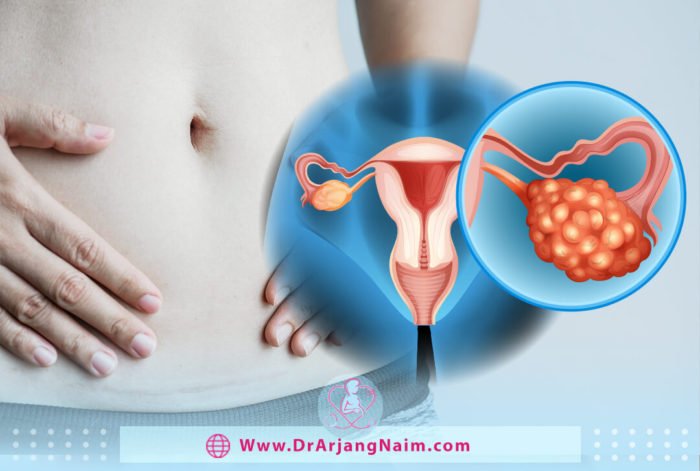Ovarian cysts are sacs that are usually filled with fluid in or on the surface of the ovary. They are common, but it is usually little or no discomfort, and the cysts are harmless. Most cysts go away without treatment within a few months.
The ovaries are two small, bean-shaped organs part of the reproductive system. A woman has two ovaries, which each of which is located on one side of the uterus. The ovaries have two main functions:
- Releases the egg every 28 days as part of the menstrual cycle
- Releases female hormones, estrogen, and progesterone, which play an important role in reproduction
Ovarian cysts may affect two ovaries simultaneously, or they may affect only one ovary. They are diseases that originate from forming one or more abnormal cysts in the ovaries.

What are the symptoms of ovarian cysts?
If the ovarian cyst ruptures, is very large, or interferes with the blood supply to the ovaries،It causes symptoms. In these cases, you may have the following symptoms:
- Abdominal bloating or swelling
- Painful bowel movements
- Pelvic pain before or during the menstrual cycle
- Painful intercourse
- Pain in the lower back or thighs
- Breast tenderness
- Nausea and vomiting
Who is at risk for ovarian cysts?
The risk increases in the following individuals and conditions:
- Hormonal problems: Hormonal problems include taking clomiphene, fertility medication that helps ovulate.
- Pregnancy: Occasionally, an ovarian cyst develops during pregnancy.
- Endometriosis : Endometriosis causes the uterine endometrial cell to form outside the uterus.
- Severe pelvic infection: If the infection spreads to the ovaries, it can cause a cyst.
- History : If you already have an ovarian cyst, you are more likely to develop a new one.
Types of ovarian cysts
There are several types of ovarian cysts. Some have severe symptoms and pain, while others do not cause any symptoms.
Functional
Most ovarian cysts occur naturally due to the menstrual cycle during a woman’s reproductive years. Before ovulation, small follicles form in the ovary. These follicles release hormones and release the egg when they ovulate.
Sometimes, a healthy follicle grows and retains its fluid after the menstrual cycle; this is a functional cyst. These cysts are almost harmless and usually go away in four to eight weeks. Functional cysts form as a normal part of the menstrual cycle. There are several types of this cyst.
Follicular cyst
A small cyst called a follicle grows in the ovary every month. The cyst contains an egg cell about 2 cm from the egg’s wall, and the egg cell is released, called ovulation. If this rupture does not occur, follicular fluid will accumulate inside the follicle, and a cyst will form.
Luteal cyst
A luteal cyst is another type of functional ovarian cyst. Following ovulation, the follicle in the ovary becomes a corpus luteum. If fluid accumulates in it, a luteal cyst or corpus luteum cyst will form.
Non-functional
In some women, their ovaries make a lot of small cysts. These cysts may grow and enlarge. Non-functional cysts include the following:
- Polycystic ovary syndrome
- Endometriosis cysts
- Hemorrhagic ovarian cyst
- Dermoid cyst
- Ovarian serous cystadenoma
- Ovarian mucinous cystadenoma
- Paraovarian cyst
- Cystic adenofibroma
- Borderline tumoral cysts
About 95% of ovarian cysts are benign and not cancerous. Functional cysts usually resolve spontaneously. However, the larger the cyst, the less likely it is to disappear. Treatment will be needed if the cyst does not go away in a few months, grows, or causes pain.
Cysts that last for more than two or three menstrual periods or occur after menopause may indicate a more severe condition and should be evaluated through urology and laparoscopy.
How is an ovarian cyst diagnosed?
Patient symptoms are an essential factor in diagnosing the disease. Testosterone, insulin, prolactin, and LH levels increase in ovarian cysts.
During a pelvic exam, your doctor may diagnose an ovarian cyst. Depending on whether the cyst is filled with fluid, solid, or a combination of the two, the doctor will perform more tests, determining the type of cyst and treatment choice.
Pelvic ultrasound
In ultrasound, the device transmits high-frequency sound waves to the body through a device that comes in contact with the skin, and the reflection of these waves will form an image of the uterus and ovaries on the screen display. The doctor analyzes the photos to see if there is a cyst in the ovary. With the help of ultrasound, you can easily identify the exact location and type of cyst and filling materials.
Laparoscopy
In this procedure, a thin, slender rod with a camera, the laparoscope, is sent into the body through a small slit. With this method’s help, the doctor can easily see the ovaries and remove the ovarian cyst. This diagnostic procedure is a type of surgery and requires anesthesia.
Blood clots CA 125 or cancer antigen 125
This method measures the level of a special protein in the blood called cancer antigen 125. The presence of this protein in women’s blood is usually a sign of ovarian cancer. The doctor will perform this test if the cyst is solid and the patient is at high risk for ovarian cancer. In non-cancerous conditions such as endometriosis, uterine fibroids, and pelvic inflammatory disease, the level of this protein in the blood will rise.

What can we do to treat ovarian cysts?
Cyst treatment covers an extensive range and can vary significantly from person to person. Therefore, people with this disease should not compare themselves regarding treatment.
Depending on the person’s age, body type, and symptoms, the treating physician will apply different treatment methods. These methods include:
- Patient monitoring: In many cases, you will have to wait and re-diagnose after a few months to determine if there is a trace of the cyst. In this procedure, if the person does not show any particular symptoms or the ultrasound shows only a small, fluid-filled simple cyst, the patient should be closely monitored to perform any other treatment.
- Medication: In this method, hormonal drugs such as birth control pills are prescribed for the person to prevent the recurrence of ovarian cysts.
- Surgery: If the ovarian cyst is large and not functional, is always growing and enlarging, stays in the body for two or three menstrual cycles, or causes severe pain, doctors recommend surgery. In surgery, the ovarian cyst will be removed from the body.
Ovarian cysts can often remove without completely removing the ovary (ovarian cystectomy). If ovulation is needed, in many cases, only the ovary where the cyst is located is removed, and the ovary remains intact. This is called oophorectomy, or the removal of one of the ovaries.
Many women develop at least one cyst during their lifetime. Fortunately, ovarian cysts are benign in 95% of cases and are easily controlled and treated with medication. They are usually asymptomatic but can sometimes cause pain or bleeding in women.
The bottom line
Ovarian cysts are common and usually harmless, so don’t worry if your doctor finds them during a pelvic exam or ultrasound. It’s possible that your cyst formed as a normal part of your menstrual cycle and will go away within a month or two. If your doctor finds a cyst of concern, follow his or her recommendations for the next steps. However, cyst pain is especially common in those who have ruptured; They can cause severe symptoms. To protect your health, learn the symptoms of ovarian cysts, and if you have signs of ovarian cysts, see a gynecologist immediately.
Additional questions
- Are ovarian cysts ever an emergency?
Yes. If accompanied by the following symptoms:
- Pain with fever and vomiting
- Sudden, severe abdominal pain
- Faintness, dizziness, or weakness
- Rapid breathing
- Heavy bleeding
2. How do ovarian cysts affect pregnancy?
Cysts are common during pregnancy. Normally, these cysts are benign and harmless. Cysts that continue to grow during pregnancy can rupture or twist or cause problems during delivery. A doctor will monitor any ovarian cysts found during pregnancy.
3. What causes prolactin’s high levels?
Hyperprolactinemia means that the level of prolactin in the blood is higher than normal. The most common cause of prolactinoma is a benign tumor in the pituitary gland. Certain health conditions and medications can also cause hyperprolactinemia.
4. What Are Paraovarian Cysts?
A para ovarian cyst is a fluid-filled sac found in the fallopian tubes near the ovaries. It may also be called a para tubal cyst or Morgan’s hydatid cyst. These cysts usually cause no symptoms and are often undiscovered unless you have surgery or other problems.
5. What can cause my CA-125 to rise?
- Cancer
- Endometriosis
- Liver cirrhosis
- Menstruation
- Pelvic inflammatory disease
- Uterine fibroids
References
https://www.mayoclinic.org/diseases-conditions/ovarian-cysts/symptoms-causes/syc-20353405
https://www.healthline.com/health/ovarian-cysts#diagnosis
https://my.clevelandclinic.org/health/diseases/9133-ovarian-cysts
https://www.webmd.com/women/guide/ovarian-cysts
https://www.womenshealth.gov/a-z-topics/ovarian-cysts
https://www.medicalnewstoday.com/articles/179031#symptoms




